
Edward Winter

A problem by George H. Derrickson, composed circa 1861, was printed on page 366 of the December 1881 issue of Brentano’s Chess Monthly:
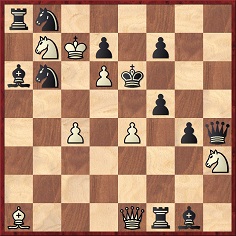
Mate in two
(2103)
Addition in George H. Derrickson:
It is unclear whether Korn [on pages 41-42 of his book America’s Chess Heritage] was using the term ‘J. Smith’ as a synonym for N.N.
The game was annotated by Emanuel Lasker on pages 168-170 of the London Chess Fortnightly, 30 July 1893.
The problem was originally published in M.J. Hazeltine’s New York Clipper column (page 373) of 10 March 1860, dedicated to Hazeltine’s wife, ‘Pfania’.
‘… that slowest of encounters, the execrable French Defence – “King’s Pawn one sneak”, as Walker omits no opportunity of stigmatizing it; or “King to Pawn’s one”, as Leonard used derisively to style it.’
From page ix of Brevity and Brilliancy in Chess by Miron J. Hazeltine (New York, 1866).
(2253)
C.N. 8368 quoted a passage from page ix of Brevity and Brilliancy in Chess by Miron J. Hazeltine (New York, 1866):
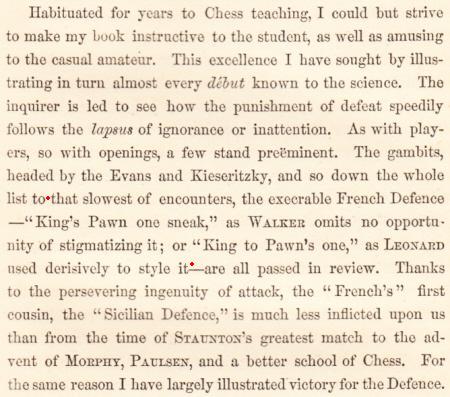
In an apparent mix-up, the ‘sneak’ reference was attributed to James A. Leonard in item 214 of unit three of Napier’s Amenities and Background of Chess-Play by W.E. Napier (New York, 1935):
‘It was the gifted Leonard, with the “first refusal” of Morphy’s mantle in his pocket, who in this country first spoke of the French Defense as the King’s Pawn Sneaks One. The obloquy of evading open-game amounted, in Civil War days, to a class consciousness. This is not hard to understand when opening play is recalled. What became terrors later on in the Ruy López were then merely growing pains. A player then had to rely on his imagination for his devices; a pre-digested game was as rare then as an original is now.
There was no good reason, many thought, to shirk open, airy, and pelting chess.
The prejudice died hard.’
See too page 211 of Napier’s Paul Morphy and The Golden Age of Chess (New York, 1957), as well as Horowitz’s references to Leonard (based on Napier’s comments) on page 84 of Chess Review, March 1950 and on page 88 of How to Win in the Chess Openings (New York, 1951).
(8386)
George Walker’s use of the word sneak regarding openings was discussed in C.N. 8368.
Michael Clapham (Ipswich, England) points out this passage in the obituary of Miron Hazeltine on page 81 of the April 1907 American Chess Bulletin:
‘Mr Hazeltine was the owner of a large and valuable chess library, which is now in the market. In addition to a large number of the standard works and magazines, the collection includes scrap books, cuttings from exchanges and a complete file of the Clipper during the 50 years he edited its chess column.’
(4964)
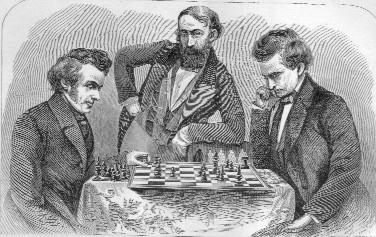
This picture was published in Brevity and Brilliancy in Chess by M.J. Hazeltine (New York, 1866). From the author’s Introduction (pages x-xi):
‘The engraving forming our frontispiece has a genuine historical interest in the records of American chess. It illustrates the first really well-appointed passage at arms in Caissa’s lists, by an American challenger against a champion of name from the old world. And the likenesses, thanks to the painstaking skill of an accomplished artist, are admirably preserved, pleasing reminders of so memorable an epoch. J.H. Turner, Esq. against Charles H. Stanley, Esq., with the renowned Herr J. Löwenthal honoring the contest with his presence. The match was fought at Washington some 20 years since, Mr Stanley winning, but not without receiving some sturdy dints in return. In the particular position given, Mr Stanley is just lifting a rook to execute the initial coup of an announced mate in three moves. As may be supposed, he wears his “very happiest expression”.’
(3503)
A high-quality scan is given in Charles Henry Stanley, courtesy of the Cleveland Public Library.
A number of C.N. items have referred to Miron James Hazeltine (1824-1907), and particularly in connection with his book Brevity and Brilliancy in Chess (New York, 1866) and his relations with James A. Leonard. A profile on pages 1-2 of the January 1894 BCM stated:
‘Mr Hazeltine invented “Miron’s Odds”, for beginners beaten too often at the rook. Remove K’s B and Kt, then castle and bid the neophyte, “Come on, Macduff!” etc. He also brought into use the “em dash” (–) for “to” in printing games; also “2d and 3d” for doubled and tripled pawns – both typographical improvements. ... [See C.N. 9738 below, as well as Castling in Chess and Chess Notation.]
Miron compiled the practical part of Marache’s Manual of Chess and was employed by Mr De Witt to complete Morphy’s Match Games, begun by Mr Stanley.’
A very similar feature was published on page 7 of the June 1897 American Chess Magazine.
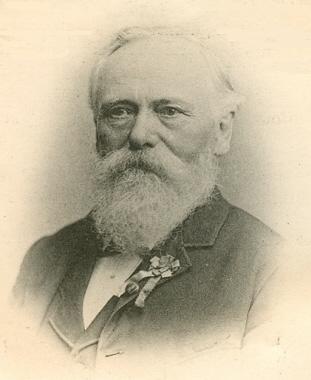
Miron James Hazeltine
Below is part of Samuel Loyd’s assessment of Hazeltine on page 1630 of the Scientific American Supplement, 15 December 1877:
‘In fact, an extended notice of our old friend would almost necessitate an autobiography of ourself, for our earliest recollections of the game are associated with his pleasant instructions at the odds of a queen, and the boyish pride we felt when he finally passed upon our first problem as worthy of publication. Our old intimacy has survived the various degrees of reduced odds, until the question of strength would be decided a shade in our favor, and the master submitted problematical questions to the judgment of the pupil.
Mr Hazeltine is most lavish in his admiration for the work of others, but has never essayed to compose a problem nor to acquire fame as a player; he has been satisfied to earn for himself the widespread reputation of an honest, liberal and enthusiastic worker for the cause of chess, who is beloved by the entire fraternity.’
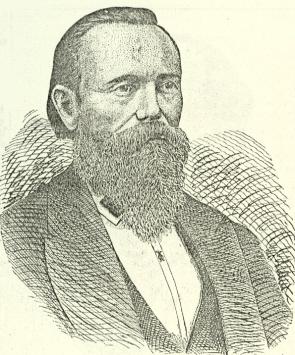
Loyd’s sketch of Hazeltine in the Scientific American Supplement
Below, from our collection, is the signed title page of Hazeltine’s copy of Chess: A Poem, in Four Parts (London, 1854):
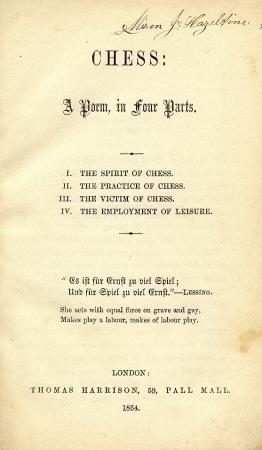
In the present item, however, we wish to focus on Miron Hazeltine’s wife (whose pseudonym was Phania). From page 33 of the February 1905 American Chess Bulletin:
‘Mrs Hazeltine, whose maiden name was Hannah M. Bryant, a relative of the late William Cullen Bryant, is a poet of no mean ability and she has steadily striven to advance the cause of the husband’s favorite game through her pretty sentiments quaintly set in rhyme. The December number of the Bulletin contained a special contribution from this gifted admirer of Caissa. Mr and Mrs Hazeltine celebrated the 50th anniversary of their marriage on 20 July 1903.’

From page 133 of the December 1904 American Chess Bulletin
In announcing Miron Hazeltine’s death, the April 1907 issue of the Bulletin (page 81) stated:
‘In a spirit of resignment and with abiding faith, she writes thus of her husband’s decease: “After traveling as partners in the rough ways of life for almost 54 years, my husband, wearied and spent, has just stopped for rest at a wayside inn, while I still struggle forward to a station just beyond, where, I, too, shall lay down the burden and we shall be forever at rest.”’
Another of her poems had appeared on pages 182-183 of the New York, 1880 tournament book: ‘To the Knights of the Fifth American Chess Congress by Mrs H. Bryant Hazeltine.’ It was reproduced on page 147 of Thomas Frère and the Brotherhood of Chess by Martin Frère Hillyer (Jefferson, 2007), and page 149 presented a portrait of her, dated 1860. The book gave her forename as Harriet rather than Hannah.
The above poem ‘A Winning Game’ was published, together with seven others on chess (‘An Enigma’, ‘Check-Mate’, ‘Chess Teachings’, ‘Chess Similes’, ‘My Problem’, ‘Caissa’s Field of the Cloth of Gold’ and ‘The Final Game’), in the very scarce book The Poems of Hannah Bryant Hazeltine (Concord, 1910).
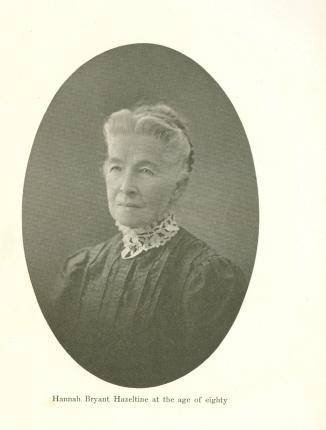
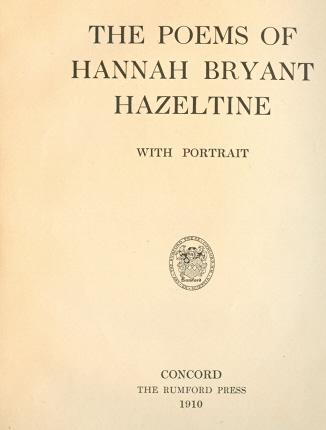
The biographical note on pages 1-2 included the following information:
‘Hannah Bryant Hazeltine was born in New Boston, NH, 20 August 1827. She was the youngest of a family of seven children born to Asa and Mehitable Snow Bryant, her father being in direct descent from Stephen Bryant, the first of the Bryant name to settle in the Old Colony in its early days. Philip Bryant, the father of William Cullen Bryant, the most noted member of the Bryant line, was first cousin to Asa Bryant ...
When about 19 years of age, in a literary society of which they both were members, Miss Bryant became acquainted with Miron J. Hazeltine, whom she afterward married. Being possessed of a good degree of poetical taste, Mr Hazeltine became interested in his wife’s intellectual pursuits and was of great assistance to her in some of her literary endeavors.
The first decade of their married life was spent in New York City, where Mr Hazeltine conducted a successful school, Mrs Hazeltine being his assistant and helper for the next two or three years ...
About the year 1862 Mr Hazeltine removed his family from New York City to New Hampshire, shortly afterward taking up his abode at The Larches, in Thornton, NH, which is the present residence of Mrs Hazeltine and still bears the name by her conferred upon it. ...
Mrs Hazeltine has four living children ...’
The book also contained these two photographs:

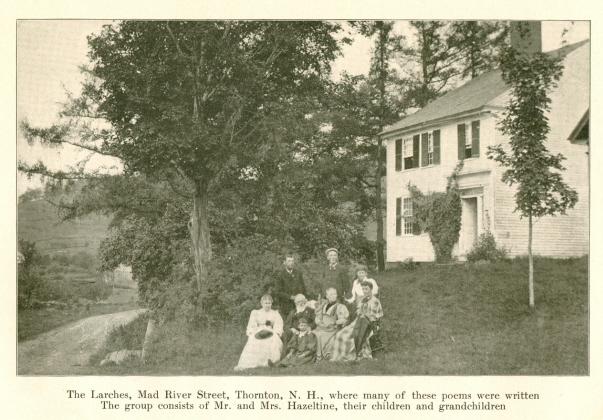
Finally for now, our copy of The Poems of Hannah Bryant Hazeltine contains a handwritten dedication by her:
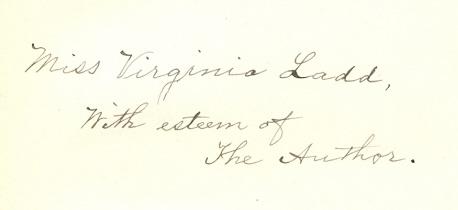
(5456)
From page 68 of the Chess Player’s Chronicle, 1 March 1878:
‘The awards of the judges in the Hartford Times Literary Chess Tourney have been announced. The authoress of the prize poem, “The Final Mate”, is Mrs Hazeltine, better known to the chess world as “Phania”. The author of the prize story, “The Two Knights’ Defence”, is Mr J. Wainwright, of Walpole, Massachusetts. The gentleman who carried off the honours in the essays, with a composition entitled “The World’s Chess Champions”, is M. Delannoy, a Frenchman resident in London.’
(8899)
See also Chess and Poetry.
Russell Miller (Camas, WA, USA) provides some information about the Hazeltines’ children, from the 1880 Federal Census:
Son: Robert E.L. (aged 16);
Daughters: Theodora (‘Theadra’) E. (13); Alice May (10); Louis P. (7).
Any details regarding Theodora will be particularly appreciated, since we possess a private letter written by her.
Pages 36-37 of the book referred to in C.N. 5456, The Poems of Hannah Bryant Hazeltine, had a composition headed ‘Fanny (1863) (An infant daughter who died 26 May 1863)’, and pages 38-39 presented the poem ‘Affliction’, in memory of another of the couple’s children who died young (James Bryant, on 9 May 1867).
(5474)
From John S. Hilbert (Amherst, NY, USA):
‘Can anyone provide concrete information confirming or contradicting Miron Hazeltine’s assertion that he was co-editor along with Daniel Willard Fiske of the Chess Monthly during 1857? Many years later, and speaking about himself in the third person, Hazeltine wrote that “He was co-editor with D.W. Fiske, A.M., of Vol. I American Chess Monthly” (American Chess Magazine, June 1897, page 7).
On pages 83-84 of Paul Morphy The Pride and Sorrow of Chess (New York, 1976) David Lawson asserted:
“The Chess Monthly was started as a joint venture by Daniel W. Fiske and Miron J. Hazeltine acting as editors and publishers. The first issue appeared in January 1857. However, Fiske observed the rising star of Morphy’s reputation during the Congress in October and wished him to join the magazine as co-editor. Since Fiske was apparently the principle [sic] party of the venture, it seems he eased Hazeltine out. Within a month after Morphy’s arrival in New York, Fiske was expressing the hope that Morphy would be editing with him, beginning in the new year. Before the middle of December the matter was settled, and the printer notified that Morphy and Fiske would be co-editors beginning January 1858.”
Lawson offered no supporting citations for any of his points. I have access only to a reprint of the Chess Monthly, but the title page of that reprint indicates that Morphy and Fiske were editors of Volume I, which apparently was bound early in 1858.
I would appreciate learning what, if any, contemporary sources either confirm or deny Hazeltine’s 1857 association with the Chess Monthly, and, if he was so associated, what evidence survives proving Fiske orchestrated his removal from the publication.’
(8129)
With regard to Chessy Words, an early occurrence of ‘chessically’ comes from Rod Edwards (Victoria, BC, Canada), in Miron J. Hazeltine’s chess column on page 196 of the New York Clipper, 9 October 1858:
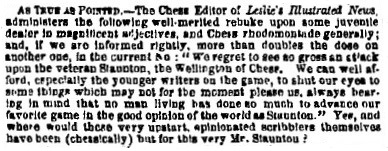
(8506)
Miron James Hazeltine – N.N.
Correspondence game (undated)
(Remove White’s king’s knight and king’s bishop.)
1 O-O e5 2 e4 Bc5 3 a3 d5 4 b4 Bb6 5 exd5 Nf6 6 c4 Bd4 7 Ra2 O-O 8 d3 Bg4 9 Qb3 h6 10 Nd2 c6 11 Ne4 Nxe4 12 dxe4 Qb6 13 Qg3 h5 14 h3. Black now discontinued the game.
Source: a letter from Hazeltine on pages 131-132 of the Brooklyn Chess Chronicle, 1 May 1883.
(9738)
The final paragraph of a letter from W.H. Russ to Professor George Allen (New York, 25 December 1859):
‘I have just been introducing a new kind of odds. I gave everything but my queen and pawns, and won three games in five. Only think how my antagonist must have played! I have seen Hazeltine give his king’s Kt and bishop and castle for his first move.’
Source: pages 107-108 of volume three of Chess Craze Bad by Harrie Grondijs (Maastricht, 2016).
(9788)
From a letter entitled ‘The Universality of Chess’ by Miron Hazeltine on pages 61-62 of the Brooklyn Chess Chronicle, 1 January 1883:
‘There is now, happily, no champion of the world – no King of Chess. In the best interests of chess may there never be another.’
(9760)
Miron James Hazeltine referred to hypnosis in connection with Lasker and the Paris tournament, on page 398 of the New York Clipper, 30 June 1900:
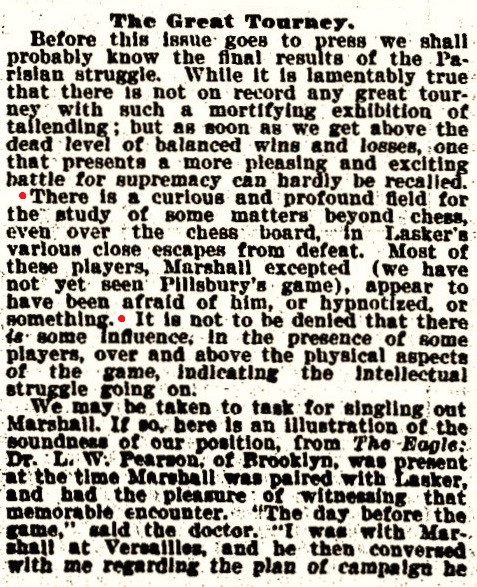
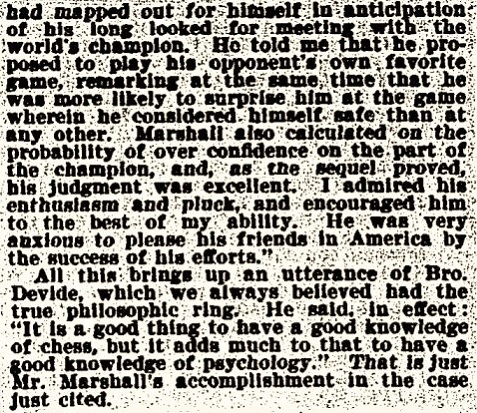
(10546)
Further to the mention of Brevity and Brilliancy in Chess by M.J. Hazeltine (New York, 1866) in our feature article on Charles Henry Stanley, the Cleveland Public Library has provided the following from one of its copies of the book:
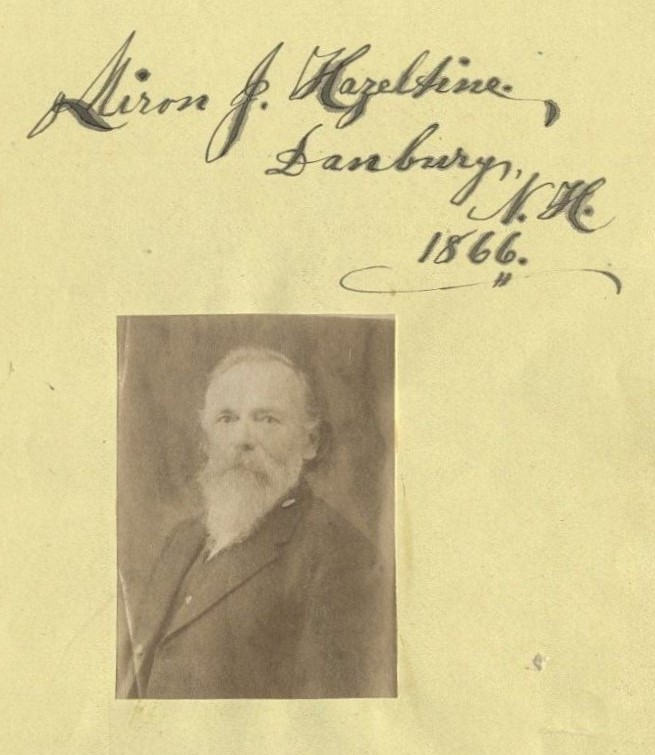
(12044)
Note: the present article aims to avoid, as far as possible, duplication of material about Hazeltine in The Tragic Life and Short Chess Career of James A. Leonard, 1841-1862 by John Hilbert (Jefferson, 2006) and in our above-mentioned feature article on Leonard.
To the Archives
for other feature articles.
Copyright Edward Winter. All rights reserved.